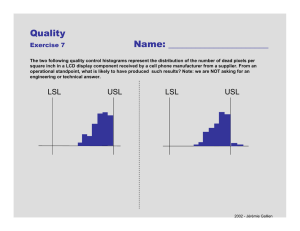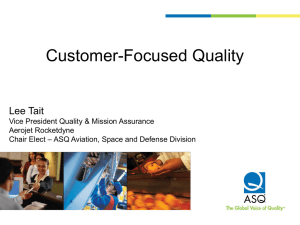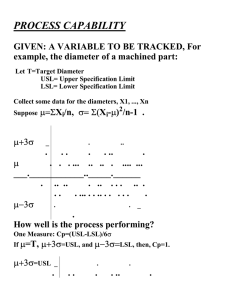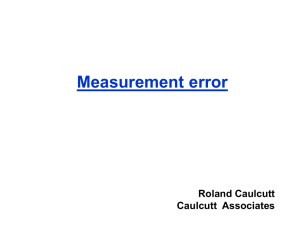Voice of the Process Panel Discussion Lee Tait, Vice President Quality Assurance
advertisement
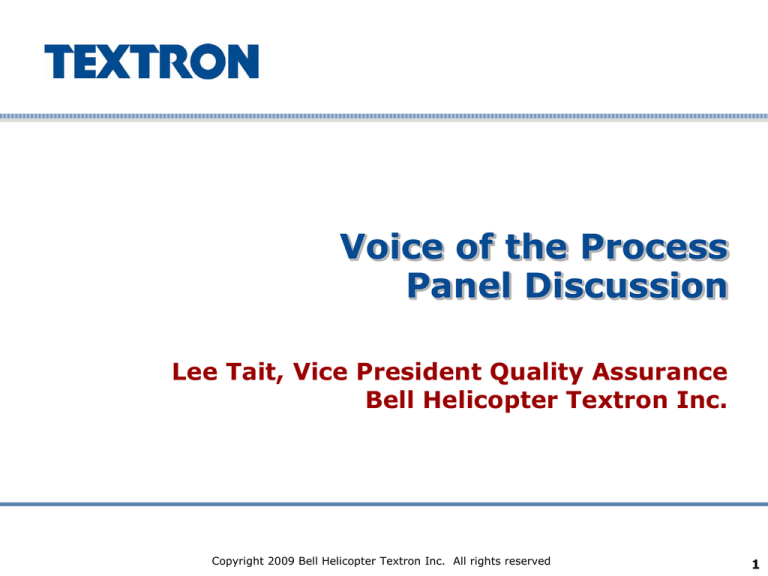
Voice of the Process Panel Discussion Lee Tait, Vice President Quality Assurance Bell Helicopter Textron Inc. Company Confidential Copyright 2009 Bell Helicopter Textron Inc. All rights reserved 1 Summary • Process capability analysis, when gathered on Critical and Key Characteristics along with Key Process Variables can improve design. • Accomplishment of this effort can be achieved by linking design requirements to current process maturity levels. • The Cp/Cpk of a given process will depict whether it can hold the required tolerances and if the process is performing to the mean of the specified requirements. • Driving improvement through process capability data yields improves designs based on current capability of the manufacturing environment, giving Engineering the insight needed to provide achievable design parameters. Copyright 2009 Bell Helicopter Textron Inc. All rights reserved 2 Agenda • What is process capability? • Using process capability to improve production – Existing Designs – New Designs • Long-term design collaboration • Benefits of understanding the Voice of the Process Copyright 2009 Bell Helicopter Textron Inc. All rights reserved 3 Process Capability The Strategy For Any Process Improvement What Is Process Capability? Process capability is the baseline measurement of how a V-22 Pylon Support process is performing. Process Data USL 0.378000 Target * LSL 0.375000 Mean 0.376133 Sample N 269 StDev (Within) 0.0002097 StDev (Overall) 0.0003468 I and MR Chart for Total hours by Process Current Individual Value 700 New The500 “Y”400 300 600 Moving Range 300 200 100 0 Overall Potential (Within) Capability 5.40 8.90 LCL=150.4Z.USL Z.LSL 5.40 Cpk 1.80 1 1 0 400 Within Mean=256.8 Z.Bench 100 500 USL UCL=363.3 200 Subgroup LSL 0 10 20 30 Time Current 40 50 Cpm 60 * Overall Capability Z.Bench 3.27 Z.USL 5.38 Z.LSL 3.27 Ppk 1.09 New 1 0.3750 0.3755 0.3760 0.3765 The “Y” Observed Performance PPM < LSL 0.00 PPM > USL 0.00 PPM Total 0.00 0.3770 Exp. "Within" Performance PPM < LSL 0.03 PPM > USL 0.00 PPM Total 0.03 0.3775 0.3780 Exp. "Overall" Performance PPM < LSL 545.01 PPM > USL 0.04 PPM Total 545.04 Centering – Put The Process On Target 1 1 1 UCL=130.7 Spread – Reduce The Variation R=40.01 LCL=0 Copyright 2009 Bell Helicopter Textron Inc. All rights reserved 4 Process Capability Improvement Tool • Engineering design requirements do not always match Manufacturing process capability • Existing Designs – Use SPC to determine the Voice of the Process – Communicate with Manufacturing and Engineering – Changes yield improved first pass yield (FPY), decreased cost and improved cycle time • New Designs – Collaboration among Engineering, Manufacturing, Quality and Programs – Engineering uses capability data during new product development – Produce product with higher FPY and lower cost Copyright 2009 Bell Helicopter Textron Inc. All rights reserved 5 Process Capability Collaboration Engineering, Manufacturing, Quality and Programs collaborate on issues using data for problem solving Sustainment Design Quality Development Manufacturing Field Data Tooling Process Understanding Planning Results in improved quality and sustainable design Copyright 2009 Bell Helicopter Textron Inc. All rights reserved 6 Voice of the Process Benefits • Improved yield • Reduced cost • Reduction in time and effort related to processing defects • Improved part flow and shipment • Optimization of process capability Copyright 2009 Bell Helicopter Textron Inc. All rights reserved 7 Process Capability Process Improvement Problem: Poor tool closures resulted in numerous blade defects for voids and twist and contour. Result: A process change was made that shifted the tool closures closer to the desired thickness. After the process change, voids were reduced by 90% and twist is moving closer to the Engineering nominal. Blade Tool Closures Blade Twist Boxplot of Tool Closure A Upp Eng Tol 0.05 Low Eng Tol Post Die Mean Pre Die Mean 0.25 0.2 0.04 0.15 0.03 New Process 0.1 11 10 9 8 7 6 5 4 3 0 2 0.02 1 Deviation 0.05 -0.05 0.01 -0.1 -0.15 0.00 852 853 864 867 944 958 960 962 964 968 969 973 975 977 978 979 981 985 987 -0.2 -0.25 Current savings = $88K, projected savings = $500K in 2009 Copyright 2009 Bell Helicopter Textron Inc. All rights reserved 8
